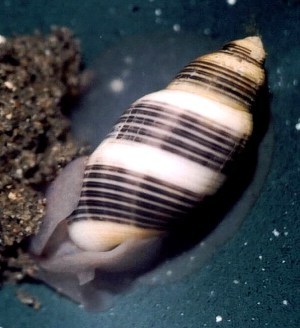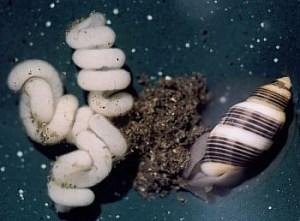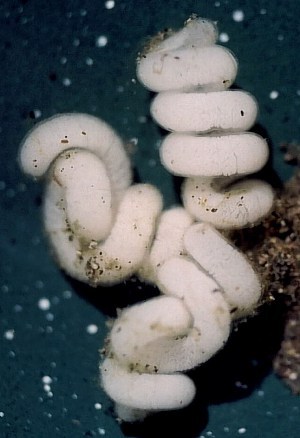

Rictaxis punctocaelatus
(Carpenter, 1864)
Order: CEPHALASPIDEA
Superfamily: ACTEONOIDEA
Family: Acteonidae
DISTRIBUTION
Alaska to Baja California, Mexico.
PHOTO
In sand on the protected outer coast just north of Cayucos, [central California, USA], 23 November 2000. Egg masses about 20 mm long. PHOTO: Jeff Goddard
Sometimes common in sand. Shell grows to about 20mm.
Reference:
• Carpenter, P.P. (1864). Supplementary report on the present state of our knowledge with regard to the mollusca of North America. Report of the British Association for the Advancement of Science, for 1863: 517-686.
Rudman, W.B., 2001 (February 4) Rictaxis punctocaelatus (Carpenter, 1864). [In] Sea Slug Forum. Australian Museum, Sydney. Available from http://www.seaslugforum.net/find/rictpunc
Related messages
Rictaxis punctocaelatus from California
July 6, 2005
From: Jim Lyle

Here's a photo of Rictaxis punctocaelatus. I didn't know that this was an opisthobranch when I took the picture! Only about 5 mm long, it looked like a pretty prosobranch snail. Since you have very few images, I thought I would forward this one to you.
Locality: Old Marineland, Palos Verdes, California , USA. Depth: 15 metres. Length: 5 mm. 04 July 2005. On top of a sunken wooden pier.
Photographer: Jim Lyle
Jim Lyle
jlyle@scubadiving.com
Lyle, J.L., 2005 (Jul 6) Rictaxis punctocaelatus from California. [Message in] Sea Slug Forum. Australian Museum, Sydney. Available from http://www.seaslugforum.net/find/14215Thanks Jim,
My personal knowledge of this animal is based on preserved animals and dead shells, which don't do it justice. I hadn't realised how white the shell could be. Usually in dead shells the horny periostracum covering the shell dries to a dirty brownish colour.
The black spot on its head, is an eye, buried in the skin, which is an indication that the acteonids are more closely related to the opisthobranchs than to the 'prosobranchs' or marine snails which have their eyes associated with stalks or tentacles..
Best wishes,
Bill Rudman
Rictaxis punctocaelatus from central California
February 6, 2001
From: Jeff Goddard

Hi Bill,
Here is a photo of the shelled cephalaspidean Rictaxis punctocaelatus and its egg masses. I found them in a mixed rocky/sandy habitat on the protected outer coast just north of Cayucos, [central California, USA] on 23 November 2000. The egg masses were about 20 mm long and anchored in sand by a long thin anchoring strand; the adults were found buried just below the sediment surface. Both the adults and egg masses were fairly abundant, which was a treat for me, as this was the first time I had found this species.
To my knowledge, species of the aeolid genus Cumanotus are the only other opisthobranchs on the west coast of North America known to lay such distinctive spiral egg masses (the egg masses of Cumanotus, however, are considerably smaller than those of Rictaxis and are laid on hydroids in fouling communities).
The embryos of Rictaxis punctocaelatus hatched as small planktotrophic veligers with typical coiled shells 137 microns long. As with other members of the Acteonidae (but not members of most other families of cephalaspideans), these veligers did not have pigmented mantle organs.
Best wishes,
Jeff
goddard@lifesci.ucsb.edu


Thanks Jeff,
Your photos reminded me that I have some photos of another acteonid, Pupa strigosa, to post on the Forum.
Best wishes,
Bill Rudman
